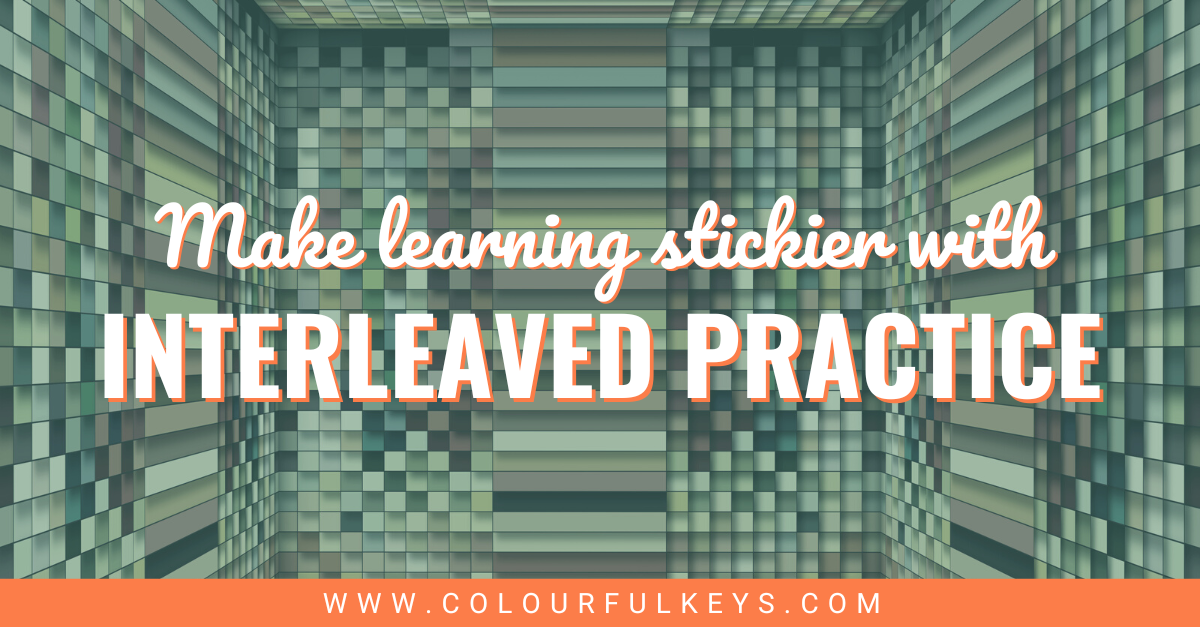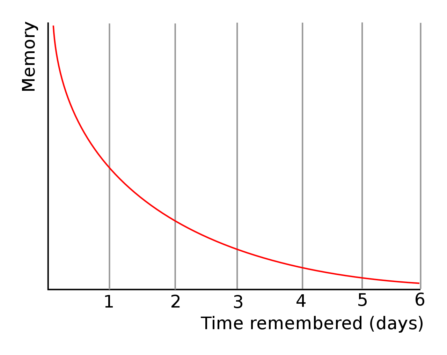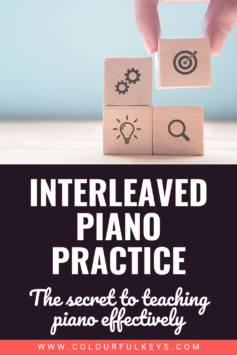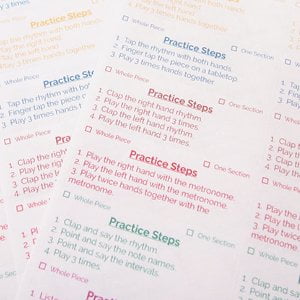“Interleaved music practice” is a phrase you may have heard bandied about in your more recent teaching years, often alongside “spaced repetitions”. But what do these terms mean? And why do they matter to us as private music teachers?

When I truly understood the value of interleaved music teaching, it changed the whole game for me. It may be counterintuitive at first, but studies have shown again and again that spaced repetitions and interleaved music practice can yield far stickier results than standard practice techniques.
And what piano teacher doesn’t want to make their students’ progress faster and more durable? Let’s dive in. 🤿
Types of Practice
There are many ways to practise music. But for this article, we’re going to focus on 3 types: blocked, spaced and interleaved.
Blocked Music Practice
Blocked practice is what most music students do instinctively. They practice one thing, then another, then another, until they finish the list and practice is over. For example:
- Piece A for 3 minutes
- Piece B for 2 minutes
- Piece C for 3 minutes
This isn’t so troublesome in the beginning, as the practice is so short that they’re not wasting much time overall. However, when practice starts to look like this…
- Scales for 1o minutes
- Piece A for 25 minutes
- Piece B for 30 minutes
…there is definitely room for improvement and increased efficiency. When we stay on one task for a long time, we feel like we’re making good progress. It seems like every time we play that tricky section it gets a little easier and if we just bash away at it for long enough we’ll “have it”.
But the reality is that when we start practice the next day, we’ll have lost a lot of that progress.
Spaced Music Practice
Learning is much more effective when we space out our practice. We need to give our brains a chance to almost forget what we learnt before pulling it back into our working memory.
The Forgetting Curve
The “forgetting curve” is a good visual representation of the idea that we forget about half of our new knowledge for each day we don’t use it.

The way I explain this to my students goes a little like this:
- When you’re practising something, you’re holding it in your working memory – right there in the front of your brain.
- What we want to do is to convince our brains that this needs to be stored deep in the brain’s library, using the hippocampus.
- The brain can’t store everything in the hippocampus, so after we stop practising something, it hops on a train from our working memory.
- The train gets faster and faster as it heads towards the back of our brains, and then it exits completely.
- We have to call it back into working memory before it reaches that exit. If we do that enough times, our brains will think it’s easier to just go ahead and store it properly, using the hippocampus, rather than keep making the same train trip.
This is not real neuroscience…just (very) loosely based on it. 🤯
But I find this quasi-scientific explanation which is connected to physicality is much more useful for students than a wishy-washy one or a metaphor. As I’m explaining this, I point to different parts of my head so they can visualise the process of skill acquisition.
Saving the New Knowledge
So this is where spaced practice comes in. We need to keep retrieving that knowledge after it has gotten aboard the forgetting train. We can’t keep it in our working memory forever, so we have to take a break from it and then retrieve it before it’s gone completely.
And some trains move faster than others. For instance, if I’m memorising a new section of a piece, I need to take only short breaks at first so that I can catch it before it escapes my brain on the TGV-style express.

Spaced practice is really what I was doing in my own practice in my late teens, only without realising it. I had way too many commitments (swimming, dancing, school, drama, etc, etc.) so I would grab just a few minutes of practice at a time, here and there. When I was studying for my final school exams, I would use practice as a way to break up the different subjects each evening.
Often, doing practice throughout the day like this is too much to ask of students. But if we can get them to do interleaved practice, we can get a lot of these benefits, and much more, within one bigger practice session.
Interleaved Music Practice
The idea of interleaved music practice and spaced repetition practice is really quite similar. In interleaved practice, you’re just practising other things where the spaced-repetition breaks would be. Something like this:
- Scales for 2 minutes
- Piece A for 5 minutes
- Scales for 2 minutes
- Piece B for 5 minutes
- Piece A for 8 minutes
- Scales for 3 minutes
- Piece B for 7 minutes
I think you get the idea. Instead of just doing things once in a large block, we loop back on them again and again for shorter chunks of time.
This can be difficult for students to implement, and it’s definitely not for beginners. We have two great resources in the Membership Library to make it easier for students to understand, and more fun for them to follow through: Lasagne and Layers and Parfait Practice.
Not a member of Vibrant Music Teaching? Join today and you’ll have instant access to our printable library with hundreds of resources, plus a plethora of continuing education courses and extensive video library and more!
Now, I’m a firm believer in teaching good practice strategies through how we teach. So it just makes sense to me that incorporating interleaved practice in students’ homes means our lessons should include what I call “interleaved teaching” as well.
Interleaved Music Teaching
Tell me if this sounds familiar….
Jemima is learning a piece called ‘Bear Picnic’ and she’s having trouble with the final section where the right hand crosses over the left.
You break it down together, practise the arm movement without playing the notes and then you ask her to try it again. It’s better…just not quite in time. So you ask her to play it again, and again, and again.
But now it starts getting worse. You keep trying it until Jemima seems to be getting too frustrated for it to be effective, so you stop and work on something else.
Too often I think we teachers persist a little too much. We need our students to progress, but it shouldn’t be all in one go – we know that. However, in the moment, our inner “determined musician” comes out and we can’t help asking them to try it just one more time.
That’s what feels most like progress to us.
But just like in students’ practice, doing a big block of repetitions in a row will not actually be as efficient or sticky as interleaved music teaching would be, breaking the repetitions up with other tasks.
We would make better overall progress if we were to revisit that part of ‘Bear Picnic’ throughout the lesson, interleaving it with other things.
This is not easy.
How to Get Started with Interleaved Music Teaching
I’ve worked on this in my own teaching and coached other teachers at Colourful Keys as they develop this skill. Make no bones about it: Interleaved music teaching can be challenging to get used to.
The biggest barrier is usually teacher time management. If you’re not on the ball, the lesson will get away from you and you’ll never return to ‘Bear Picnic’. You’ll probably conclude that you would have been better off just trying one more pass while you were on it.
But I believe interleaved music teaching is a skill that’s worth the effort.
To make it easier on yourself, start with interleaving just one thing. Choose one section of a piece or a scale, and insert that between every lesson activity.
Once you get used to that, you can move gradually towards true interleaving, where you’re revisiting multiple items throughout the lesson.
Bonus Tip: Save Time with Book Management
One huge “time suck” in piano lessons is what I call the “student shuffle”. The teacher asks the kid to take out ‘Five-Finger Rock’ and they start hunting through their piano bag.
The teacher tells them the colour of the book and a few more precious seconds pass before they eventually find it, pull it out, flip it over (since it’s upside down, of course) and then start looking for the correct page.
Look, there’s a time and a place for children to work on developing their executive functioning skills. I would argue that piano lessons ain’t it. We get so little time with our students each week and (unlike school) we’re usually one-on-one or one-on-a-few. We don’t need them to take out their own books!
It requires a little multitasking, but if you can master the art of silently preparing the next activity (game, book, sheet music) whilst you listen to your student play, you will save so many minutes.
And you’ll be much more capable of interleaving lesson tasks as there will be no in-betweeny shuffling time. 🔀

Do you interleave your teaching or space out repetitions?
I’d love to hear about your experience with this in lessons and in your own practice. Share your thoughts in the comments below.
You can find more practice tips, tricks and resources on my hub page devoted to teaching practice skills, like these amazing ‘Practice Step Stickers’. Enter your info below, and I’ll send a free copy right to your inbox.

Subscribe to the newsletter and get the practice step stickers.
Enter your details to subscribe to the newsletter for piano teachers with information, tips and offers.
I hate spam as much as you do! I will only send you emails related directly to piano teaching and you can unsubscribe at any time.

I’m very excited to start trying this with a few students this week!!
That’s awesome, Nikki! We’d love to hear how it went:)